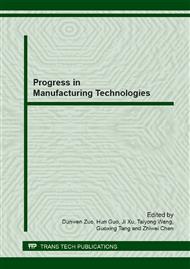p.113
p.119
p.123
p.133
p.139
p.143
p.149
p.155
p.161
The Electro-Hydraulic Control Directional Valve Based on Magneto-Rheological Fluid
Abstract:
The electro-hydraulic control directional valve based on magneto-rheological fluid using in hydraulic support is proposed. The magneto-rheological fluid represents favorable flow liquid state without external magnetic field, but it can represent mechanics quality of similarity solid in strong magnetic field. The magneto-rheological fluid may become solid within milliseconds under the action of an external magnetic field, which can realize intelligent control of hydraulic system and overcome shortcoming of traditional hydraulic valve. The electro-hydraulic control directional valve uses magneto-rheological fluid as controlling fluid, and adjusts pressure difference of action main control valve between left end and right end though changing excitation coil current of magneto-rheological valve. The electro-hydraulic control directional valve based on magneto-rheological fluid can satisfy the self-feeding hydraulic support using requirements and has low manufacturing cost. The installation and using of the electro-hydraulic control valve is more convenient and fast. It reduces the point of failure of the hydraulic supports piping system and makes hydraulic support more secure and reliable.
Info:
Periodical:
Pages:
139-142
Citation:
Online since:
July 2013
Price:
Сopyright:
© 2013 Trans Tech Publications Ltd. All Rights Reserved
Share:
Citation:


